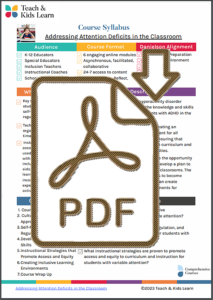Making Math Accessible Inclusion Strategies, Grades K-12
Course Description
 |
This course on enriching math instruction for neurodiverse learners will provide educators with the knowledge and skills necessary to design and implement inclusive, rigorous instruction that supports students’ development of math skills and knowledge. Neurodiverse learners include students with ADHD, students on the autism spectrum, and students diagnosed with learning disabilities. |
The course will cover explicit techniques to teach math concepts and skills to support the understanding and retention of math content. Educators will learn how to provide rigorous and culturally responsive instruction and feedback that considers the unique strengths and needs of neurodiverse learners.
In addition, the course will examine the role of the teacher in developing students’ math reasoning, problem-solving, critical thinking, and logic.
Throughout the course, educators reflect on their teaching practices and develop rigorous, equitable, and inclusive math instruction. The goal of the course is to empower educators to become confident and competent teachers prepared to teach complex math skills to neurodiverse students.
Essential Questions
- What are the key elements of math proficiency?
- What is the relationship between high-quality instruction achievement for neurodiverse students?
- How do neurodiverse students make mathematical connections, communicate their reasoning, collaborate with peers, and build confidence as mathematicians?
- How does formative assessment inform instruction for neurodiverse mathematicians?
| Course Agenda
Course Introduction
Course Wrap Up |
| Course Syllabus |
|
Comments from Teachers
“I really find the task analysis a helpful strategy. Also, understanding the different levels of math understanding and skills students must develop to gain proficiency is very helpful.”
“The course was an eye-opener in helping me realize that each student is diverse and, therefore, what may work with some students doesn’t necessarily work with all. A multi-faceted approach to teaching is beneficial to all students.”
Danielson Teacher Framework Course Alignment


